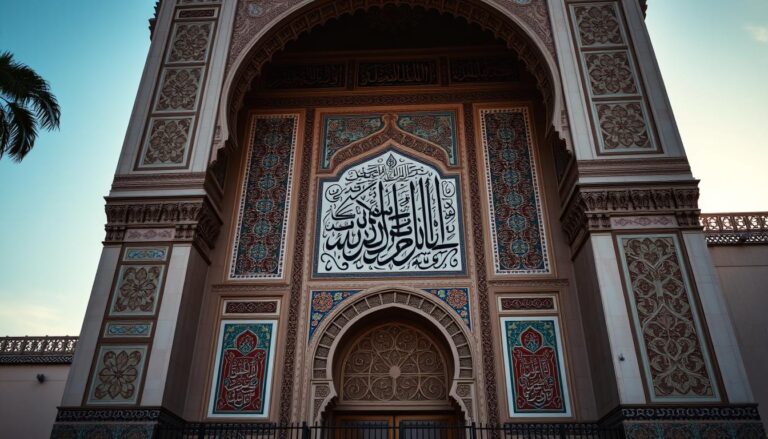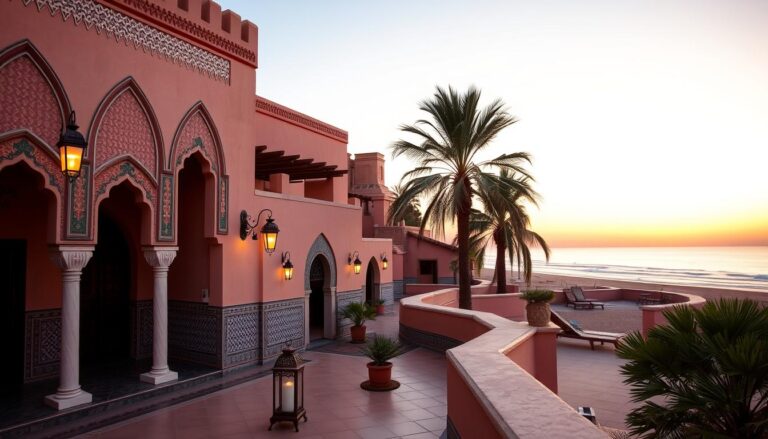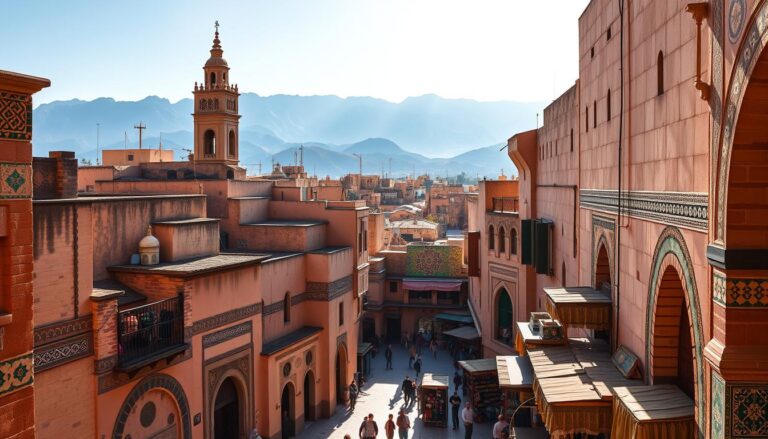Ever wondered about Moroccan riads? These courtyard homes are full of history and charm. They have intricate details and a deep cultural heritage. But what’s their story, and how have they shaped Morocco’s architecture over time?
Key Takeaways
- Riads have made Morocco a top tourist spot, showing off the country’s traditional life.
- The roots of riad architecture go back to ancient times. It mixes Roman villas, Persian gardens, and Islamic culture.
- Originally, riads were grand homes for wealthy merchants. Now, they’re luxury guest houses for those who love Moroccan history and culture.
- Traditional riads have inward-facing layouts, high walls, and central courtyards. These features offer privacy and protection from the outside world.
- Preserving and restoring historic riads is crucial in Morocco. It helps keep this iconic architectural style alive for future generations.
Origins and Influences of Riad Architecture
The design of Moroccan riads comes from ancient Roman and Persian styles. These styles merged with Islamic culture. Riads have an inward layout, centered on a calm courtyard. This design comes from Roman villas, offering privacy and peace.
Ancient Roman and Persian Inspirations
Mesopotamian influence is seen in Moroccan architecture, especially in Persian gardens. These gardens were designed to look like paradise. The mix of Roman and Persian designs created the riad’s beautiful look.
Islamic Flourishing and Cultural Integration
In the 7th century, Islamic rulers changed Moroccan architecture. They added beautiful ornamentation and detailed tilework. The Idrisid dynasty used elements from Andalusia, creating a cultural mix.
Riads show this mix, combining function with art. They reflect a multicultural ethos.
“Riads are a testament to the blending of eastern and western design, where the ancient Roman and Persian architectural influences seamlessly integrate with the Islamic flourishing and cultural integration, creating a unique and captivating aesthetic.”
Defining Features of Traditional Moroccan Riads
Dive into the world of traditional Moroccan riads, where architecture, design, and culture blend beautifully. These homes, deeply connected to Morocco’s history, have a unique layout that focuses on privacy and protection. The central courtyard, often with a calm fountain or green gardens, is the riad’s heart. It’s a peaceful spot that sets the mood for the whole place.
Moroccan riads show off the region’s amazing craftsmanship and creativity. They are covered in detailed ornamentation and tilework. Features like stucco cornices, carved wooden screens, and beautiful geometric tile work (zelige) highlight the skill of Moroccan artisans. They create a stunning visual experience for everyone.
“Riads represent Moroccan values of family life, privacy, and hospitality.”
The rooms, called bâyts, surround the central courtyard. Each room has its purpose, like public areas, dining rooms, and private spaces. This layout not only boosts privacy but also shows Moroccan values of family, welcoming guests, and living in harmony with nature.
Traditional Moroccan riads capture the country’s architectural and cultural essence. They offer a unique, personal experience or a chance to explore Moroccan craftsmanship. Staying in a riad is a memorable adventure.
Evolution of Riads Through Centuries in Moroccan Architecture
The history of riads in Morocco is truly captivating. It shows how the country’s culture and history have changed over time. These courtyard houses have evolved, showing the big changes in Moroccan society.
In the last century, riads were often ignored as new cities were built. But, thanks to European homeowners, they are now being restored. Today, riads are not just homes but also luxury guest houses. They offer a mix of old culture, modern comfort, and green living.
Riads still amaze visitors with their unique design and history. They show the influence of ancient Romans, Persians, and Islam. Their evolution highlights the importance of these spaces in Moroccan culture.
“The architectural evolution of riads in Morocco is a testament to the country’s rich cultural heritage, where the past and present seamlessly intertwine to create a truly unique and captivating experience for visitors.”
Now, Moroccan architects blend old traditions with new designs. They aim to make buildings that are good for the environment and respect the culture of riads. This shows how Moroccan architecture can stay true to its roots while still being modern.
Riads as Havens for the Elite and Luxury Travelers
Riads have changed over time, becoming special places for the elite. They offer privacy, comfort, and a deep connection to Morocco’s history. These homes of the wealthy now welcome guests, offering a peaceful escape from the outside world.
The beauty of riads is in their detailed designs. Guests can relax under the stars in a courtyard, surrounded by quiet. Riads are more than places to stay; they are experiences filled with luxury and cultural heritage.
In Marrakech, riads are famous for their stunning designs and luxury. They feature Moroccan crafts and offer a glimpse into the city’s past. In Fes, riads show off the city’s history through their tile work and wood carvings. Luxury desert camps in Merzouga, like Riad Merzouga and Kasbah Hotel Tombouctou, offer peaceful Sahara desert escapes with camel treks at dawn.
“Riads have transformed into symbols of luxury and cultural preservation, offering travelers unique experiences immersed in Morocco’s rich history and architectural heritage.”
Riads in Marrakech and Fes mix old charm with modern comforts. They have air-conditioning, Wi-Fi, and updated bathrooms for a relaxing stay. These exclusive retreats in Morocco offer privacy, comfort, and historical significance. Riads have become luxury accommodations that keep Moroccan cultural heritage tourism alive, providing a peaceful, private sanctuary for travelers.
Renowned Riads in Marrakech, Fes, and Merzouga
Morocco’s riads in Marrakech, Fes, and Merzouga offer a peek into the country’s rich culture. They are a luxurious retreat with stunning designs. These places show off Moroccan architecture and hospitality at its best.
Marrakech’s Exquisite Riads
In Marrakech, riads are known for their detailed wooden doors and beautiful floors. They have peaceful courtyard gardens. These renowned riads in Marrakech mix traditional Moroccan style with modern comforts. Guests get to experience Moroccan culture deeply.
Riads like La Maison Arabe and La Sultana Marrakech are top choices. They are part of Small Luxury Hotels of the World. These places highlight Moroccan craftsmanship in luxury riad accommodations.
Fes: A Gateway to the Past
Fes is filled with riads that connect you to its ancient history. Some renowned riads in Fes are hidden in the old medina’s alleys. They have Andalusian gardens and terraces with amazing views.
Riad Fes, Riad Maya, and Karawan Riad are examples. They offer cultural heritage experiences in Fes. These riads blend nature and architecture beautifully.
In Merzouga, riads provide a luxurious desert retreat. They offer stunning views of the dunes. Guests can dive into Morocco’s desert beauty.
“Riads are not just a place to stay, but a gateway to understanding the heart and soul of Moroccan culture.”
Conclusion
The evolution of riads in Moroccan architecture shows the lasting cultural significance of these traditional courtyard houses. They started blending influences from Rome, Persia, and the Islamic world. Riads have kept travelers captivated and helped preserve Moroccan design heritage.
Now, riads have become luxury accommodations. They’ve helped revitalize historic medinas and support sustainable tourism.
Today, these architectural gems give visitors a unique chance to dive into Morocco’s soul. They experience the calm, beauty, and cultural legacy that riads have held for centuries. The preservation and restoration of riads ensure this tradition will continue to inspire and delight.
It will safeguard the country’s cultural heritage for future generations.
As Morocco grows, the lasting presence of riads shows the country’s strong commitment to preserving its architectural heritage. It offers unique travel experiences that celebrate Morocco’s rich cultural tapestry.
Source Links
- Moroccan architecture
- From Islamic to Art Deco: A rich history of Moroccan architecture
- Morocco’s Rich Architectural History
- A brief history of Moroccan riads – Marrakech Riads | Site Officiel
- Riad (architecture)
- The Art Of The Moroccan Riad – Metropolis
- What is a Riad – The Moroccan Riad | Private Morocco tours
- Discovering the Enchanting World of Riads: Moroccan Tranquility Unveiled
- Learning from the ancients, modern Moroccan architecture forges new identity | Africanews
- Legends of the Road of a Thousand Kasbahs – ARCHAEOTRAVEL.eu
- Riads of Morocco: a Brief History
- Marrakech Riads: From Moorish Marvels to Luxury Retreats – Realtary
- Accommodation Guide – Best Riads in Fes, Morocco – Brogan Abroad
- No title found
- The charm and beauty of riad architecture in Marrakech – Darchibania
- The Riads of Morocco as tourist accommodation products: characteristics and potentialities
- A Journey Through Time and Culture – Archi kouidich

The Editorial Team is a passionate group of Morocco enthusiasts dedicated to sharing the beauty, culture, and wonders of this captivating country. With diverse backgrounds and a deep love for travel, we strive to bring you engaging and informative content that inspires your Moroccan adventures. From uncovering hidden gems and sharing local insights to exploring mouthwatering cuisine and showcasing the vibrant lifestyle, our team is committed to providing you with valuable resources and exciting stories that enhance your exploration of Morocco. Join us on this journey as we celebrate the rich heritage and unforgettable experiences that make Morocco truly special.







